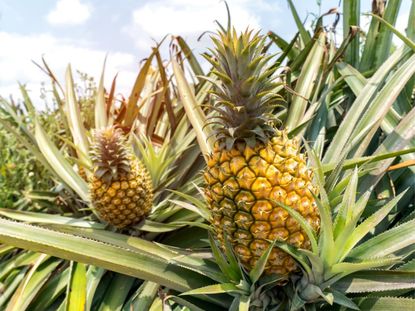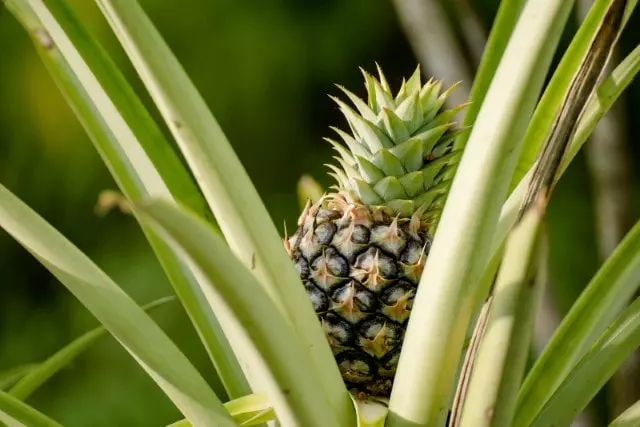Understanding the Nutritional Needs of Pineapple Plants
Pineapple plants require a balanced diet of essential nutrients to promote healthy growth and fruit production. Fertilization plays a crucial role in providing these nutrients, and understanding the nutritional needs of pineapple plants is vital for optimal growth. Nitrogen, phosphorus, and potassium are the primary macronutrients required by pineapple plants, and a deficiency in any of these nutrients can impact plant growth and fruit production.
Nitrogen is essential for leaf growth and development, while phosphorus promotes root growth and fruit production. Potassium helps with overall plant health and resistance to disease. In addition to these macronutrients, pineapple plants also require micronutrients like magnesium, sulfur, and calcium. A balanced fertilizer that provides the right mix of these nutrients is essential for optimal growth.
When it comes to fertilizing a pineapple plant, it’s essential to choose a fertilizer that is specifically formulated for tropical plants like pineapple. A fertilizer with a balanced N-P-K ratio (nitrogen-phosphorus-potassium) of 10-10-10 or 20-20-20 is suitable for pineapple plants. However, it’s also important to consider the specific needs of your plant, including the soil type and pH level.
Soil pH plays a critical role in nutrient availability, and pineapple plants prefer a slightly acidic to neutral soil pH between 5.5 and 6.5. If the soil pH is too high or too low, it can impact nutrient uptake and plant growth. Regular soil testing can help determine the soil pH and nutrient levels, ensuring that your pineapple plant receives the necessary nutrients for optimal growth.
By understanding the nutritional needs of pineapple plants and providing the right balance of nutrients, you can promote healthy growth and fruit production. In the next section, we’ll discuss how to choose the right fertilizer for your pineapple plant.
Choosing the Right Fertilizer for Your Pineapple Plant
When it comes to fertilizing a pineapple plant, choosing the right fertilizer is crucial for optimal growth and fruit production. With so many options available, it can be overwhelming to select the best fertilizer for your plant’s specific needs. In this section, we’ll discuss the different types of fertilizers available for pineapple plants, including organic and inorganic options, and provide tips on how to select the best fertilizer for your plant.
Organic fertilizers, such as compost, manure, and fish emulsion, are a popular choice for pineapple plants. These fertilizers release nutrients slowly, promoting healthy growth and fruit production. Inorganic fertilizers, such as synthetic fertilizers, provide a quick burst of nutrients but can be more prone to over-fertilization. When choosing an inorganic fertilizer, look for a balanced N-P-K ratio (nitrogen-phosphorus-potassium) of 10-10-10 or 20-20-20.
Another option is to use a fertilizer specifically formulated for tropical plants like pineapple. These fertilizers typically contain a blend of nutrients tailored to the specific needs of pineapple plants. Some popular brands include Miracle-Gro and Scotts. When selecting a fertilizer, be sure to read the label and look for the following nutrients: nitrogen, phosphorus, potassium, magnesium, sulfur, and calcium.
It’s also important to consider the soil type and pH level when selecting a fertilizer. Pineapple plants prefer a slightly acidic to neutral soil pH between 5.5 and 6.5. If the soil pH is too high or too low, it can impact nutrient uptake and plant growth. Regular soil testing can help determine the soil pH and nutrient levels, ensuring that your pineapple plant receives the necessary nutrients for optimal growth.
When learning how to fertilize a pineapple plant, it’s essential to choose a fertilizer that is specifically formulated for your plant’s needs. By selecting the right fertilizer, you can promote healthy growth and fruit production, and ensure your pineapple plant thrives.
How to Fertilize Your Pineapple Plant for Maximum Benefit
Fertilizing a pineapple plant requires careful attention to detail to ensure maximum benefit. When learning how to fertilize a pineapple plant, it’s essential to follow a few simple steps to promote healthy growth and fruit production. In this section, we’ll provide step-by-step instructions on how to fertilize a pineapple plant, including the frequency and amount of fertilizer to apply, and how to avoid over-fertilization.
Step 1: Determine the Fertilization Schedule
Pineapple plants require regular fertilization, but the frequency depends on the plant’s age and growth stage. For young plants, fertilize every 2-3 weeks, while mature plants require fertilization every 4-6 weeks.
Step 2: Choose the Right Fertilizer Amount
The amount of fertilizer to apply depends on the plant’s size and growth stage. For small plants, use 1-2 tablespoons of fertilizer per application, while larger plants require 2-3 tablespoons.
Step 3: Apply the Fertilizer
Apply the fertilizer around the base of the plant, avoiding the leaves and crown. Water the plant thoroughly after fertilization to ensure the nutrients are absorbed.
Step 4: Monitor and Adjust
Monitor the plant’s response to fertilization, adjusting the frequency and amount of fertilizer as needed. Over-fertilization can lead to nutrient burn, while under-fertilization can impact growth and fruit production.
Additional Tips:
Avoid fertilizing during the winter months when the plant is dormant. Also, be cautious not to over-fertilize, as this can lead to nutrient imbalances and impact plant health.
By following these simple steps and tips, you can ensure your pineapple plant receives the necessary nutrients for optimal growth and fruit production. Remember to always choose a fertilizer specifically formulated for tropical plants like pineapple, and adjust the fertilization schedule and amount based on the plant’s age and growth stage.
The Importance of Soil pH in Pineapple Plant Fertilization
Soil pH plays a critical role in pineapple plant fertilization, as it affects the availability of essential nutrients for the plant. Understanding the importance of soil pH and how to test and adjust it can help ensure optimal nutrient uptake and promote healthy growth and fruit production.
Soil pH is a measure of the acidity or alkalinity of the soil, with a pH range of 0-14. Pineapple plants prefer a slightly acidic to neutral soil pH between 5.5 and 6.5. If the soil pH is too high or too low, it can impact nutrient availability and plant growth.
For example, if the soil pH is too high (above 7.0), it can lead to nutrient deficiencies, particularly in micronutrients like iron and zinc. On the other hand, if the soil pH is too low (below 5.5), it can lead to nutrient toxicity, particularly in macronutrients like nitrogen and phosphorus.
To test the soil pH, you can use a soil testing kit or send a sample to a laboratory for analysis. Once you have determined the soil pH, you can adjust it by adding lime to raise the pH or sulfur to lower it.
It’s also important to note that soil pH can affect the availability of nutrients in the fertilizer. For example, if the soil pH is too high, it can reduce the availability of phosphorus, making it less effective. By adjusting the soil pH to the optimal range, you can ensure that the fertilizer is working effectively and providing the necessary nutrients for the plant.
When learning how to fertilize a pineapple plant, it’s essential to consider the soil pH and adjust it accordingly. By doing so, you can promote healthy growth and fruit production, and ensure your pineapple plant thrives.
Additional Nutrients for Pineapple Plant Growth
In addition to the essential macronutrients like nitrogen, phosphorus, and potassium, pineapple plants also require additional nutrients to promote healthy growth and fruit production. Magnesium, sulfur, and calcium are some of the key micronutrients that play a crucial role in pineapple plant growth.
Magnesium is essential for photosynthesis, cell wall development, and fruit production. A magnesium deficiency can lead to yellowing of leaves, reduced fruit production, and increased susceptibility to disease. To supplement magnesium, you can use magnesium sulfate or magnesium nitrate.
Sulfur is important for plant defense, resistance to disease, and nutrient uptake. A sulfur deficiency can lead to reduced plant growth, yellowing of leaves, and increased susceptibility to disease. To supplement sulfur, you can use sulfur-based fertilizers or elemental sulfur.
Calcium is essential for cell wall development, root growth, and fruit production. A calcium deficiency can lead to reduced plant growth, yellowing of leaves, and increased susceptibility to disease. To supplement calcium, you can use calcium nitrate or calcium sulfate.
When learning how to fertilize a pineapple plant, it’s essential to consider the role of these additional nutrients in promoting healthy growth and fruit production. By supplementing these nutrients, you can ensure that your pineapple plant receives the necessary nutrients for optimal growth and fruit production.
Some tips for supplementing these nutrients include:
Using a balanced fertilizer that contains magnesium, sulfur, and calcium.
Applying magnesium, sulfur, and calcium supplements separately, following the recommended application rates.
Monitoring soil pH and adjusting it accordingly to ensure optimal nutrient uptake.
By following these tips and providing your pineapple plant with the necessary nutrients, you can promote healthy growth and fruit production, and ensure your pineapple plant thrives.
Common Mistakes to Avoid When Fertilizing Your Pineapple Plant
When learning how to fertilize a pineapple plant, it’s essential to avoid common mistakes that can impact plant growth and fruit production. Over-fertilization, under-fertilization, and using the wrong type of fertilizer are some of the most common mistakes to avoid.
Over-fertilization can lead to nutrient burn, reduced plant growth, and increased susceptibility to disease. This can occur when too much fertilizer is applied, causing an excessive buildup of nutrients in the soil. To avoid over-fertilization, follow the recommended application rates and monitor soil pH levels.
Under-fertilization can lead to reduced plant growth, yellowing of leaves, and decreased fruit production. This can occur when too little fertilizer is applied, causing a nutrient deficiency. To avoid under-fertilization, ensure that the fertilizer is applied at the recommended frequency and amount.
Using the wrong type of fertilizer can also impact plant growth and fruit production. For example, using a fertilizer that is too high in nitrogen can lead to excessive vegetative growth, while using a fertilizer that is too low in phosphorus can lead to reduced fruit production. To avoid using the wrong type of fertilizer, choose a balanced fertilizer that is specifically formulated for pineapple plants.
Other common mistakes to avoid include:
Failing to monitor soil pH levels, which can impact nutrient uptake and plant growth.
Not adjusting fertilization schedules and nutrient levels as the plant grows and matures.
Not providing adequate water and nutrients to the plant, leading to reduced growth and fruit production.
By avoiding these common mistakes, you can ensure that your pineapple plant receives the necessary nutrients for optimal growth and fruit production. Remember to always follow the recommended application rates, monitor soil pH levels, and adjust fertilization schedules and nutrient levels as needed.
Monitoring Your Pineapple Plant’s Response to Fertilization
Monitoring your pineapple plant’s response to fertilization is crucial to ensure that the plant is receiving the necessary nutrients for optimal growth and fruit production. By observing changes in growth, fruit production, and overall plant health, you can adjust your fertilization strategy to meet the plant’s specific needs.
Some key indicators to monitor include:
Leaf color and texture: A healthy pineapple plant should have dark green, glossy leaves. If the leaves are yellowing or becoming scorched, it may be a sign of over-fertilization or nutrient deficiency.
Plant growth: Monitor the plant’s growth rate, including the development of new leaves, stems, and fruit. A healthy pineapple plant should be growing steadily, with new growth emerging regularly.
Fruit production: Monitor the plant’s fruit production, including the number and size of fruit. A healthy pineapple plant should be producing fruit regularly, with the fruit growing in size and ripening evenly.
Soil pH: Monitor the soil pH regularly to ensure that it is within the optimal range for pineapple plants (5.5-6.5). Adjust the soil pH as needed to ensure optimal nutrient uptake.
By monitoring these indicators, you can adjust your fertilization strategy to meet the plant’s specific needs and ensure optimal growth and fruit production. Remember to keep a record of your observations and adjust your fertilization schedule accordingly.
Some tips for monitoring your pineapple plant’s response to fertilization include:
Keep a fertilization log to track the type and amount of fertilizer applied, as well as the date and time of application.
Take regular photographs of the plant to track changes in growth and fruit production.
Monitor the plant’s response to fertilization over time, adjusting the fertilization schedule as needed to ensure optimal growth and fruit production.
By following these tips and monitoring your pineapple plant’s response to fertilization, you can ensure that your plant is receiving the necessary nutrients for optimal growth and fruit production.
Long-Term Fertilization Strategies for Pineapple Plant Health
Developing a long-term fertilization strategy for your pineapple plant is crucial to ensure optimal growth and fruit production over time. By adjusting fertilization schedules and nutrient levels as the plant grows and matures, you can promote healthy growth and fruit production, and prevent nutrient deficiencies and other problems.
Here are some tips for developing a long-term fertilization strategy for your pineapple plant:
Adjust fertilization schedules based on the plant’s growth stage. For example, young plants may require more frequent fertilization, while mature plants may require less frequent fertilization.
Adjust nutrient levels based on the plant’s specific needs. For example, pineapple plants require more potassium during the fruiting stage, so you may need to increase the potassium levels in your fertilizer.
Consider using a slow-release fertilizer, which can provide nutrients to the plant over a longer period of time.
Monitor the plant’s response to fertilization and adjust the fertilization strategy as needed.
Keep a record of your fertilization schedule and nutrient levels, and adjust the strategy based on the plant’s response.
By following these tips and developing a long-term fertilization strategy, you can promote healthy growth and fruit production in your pineapple plant, and ensure optimal growth and fruit production over time.
Some additional considerations for long-term fertilization strategies include:
Soil testing: Regular soil testing can help you determine the nutrient levels in your soil and adjust your fertilization strategy accordingly.
Integrated pest management: Consider using integrated pest management techniques, such as crop rotation and biological control, to reduce the need for fertilizers and pesticides.
Organic fertilizers: Consider using organic fertilizers, such as compost and manure, which can provide nutrients to the plant while also improving soil health.
By incorporating these considerations into your long-term fertilization strategy, you can promote healthy growth and fruit production in your pineapple plant, and ensure optimal growth and fruit production over time.







:max_bytes(150000):strip_icc()/pineapple-growing-in-field-7b9f5063eaf94e179380f69e09a5c357.jpg)
